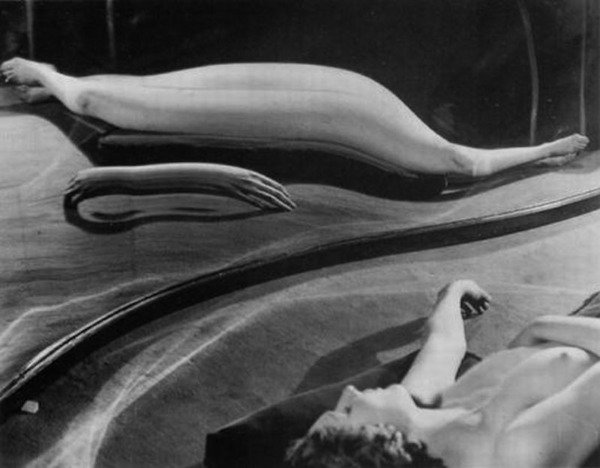Three Projects
dal 29/1/2015 al 13/3/2015
Segnalato da
Zlem Altin
Peter Coffin
Tacita Dean
Richard Hughes
Manuela Leinhob
Ann Lislegaard
Henrik Olesen
Lea Porsager
André Kertesz
Tomasz Kowalski
Harry Sanderson
Markus Schinwald
Emily Wardill
Emily Wardill
29/1/2015
Three Projects
carlier | gebauer, Berlin
The German premiere of Emily Wardill's film, When You Fall Into a Trance; the group show I hear your voice reflected in a glass and it sounds like it is inside of me; and new work by Finnish artist Marianna Uutinen.

carlier | gebauer is pleased to present three projects: the German premiere of
Emily Wardill‘s film, When You Fall Into a Trance; the group show I hear your
voice reflected in a glass and it sounds like it is inside of me; and new work
by Finnish artist Marianna Uutinen, opening 30 January 2015 from 6–9pm.
"Second Reversal: Sight touches and touch sees. Break the cycle even for a
moment you fall. Sight walks or life ceases. He who doesn't know how to walk
puts one foot in front of the other; he who does puts an eye in front of each
shoe." – Michel Serres, (Variations on the Body)
When You Fall Into a Trance tells the story of Dominique – a neuroscientist who
both researches and manifests the belief that memories are stored in flesh. Her
primary patient, Simon, is afflicted with a neural disorder that affects his
understanding of the position of his limbs and the effort required to move
them. He can no longer control ordered movement and is unable to activate his
own body without looking at it. If you turn off the light in a room, he falls
over. Simon‘s perceptual boundaries have shifted. Even simple acts like pouring
a glass of water have become unachievable. Dominique helps Simon relearn how to
move by retraining his mind. He must first imagine his gestures so that he can
actualize them. When You Fall Into a Trance depicts Dominique‘s kaleidoscopic
workaholism, estranged relationship with her daughter, and recourse to Internet
dating as her work and personal life begin to meld. The film embodies the disl-
ocation between intent and form, a romance of machines, and the mechanization
of emotions.
In parallel, the gallery will present the group show titled, I hear your voice
reflected in a glass and it sounds like it is inside of me, curated by Emily
Wardill in conversation with Jesi Khadivi. The exhibition was conceived in
relation to Wardill’s research for her film, which is based on the real-life
story of Ian Waterman and his enigmatic proprioceptive disorder. Like the
reflections of mercury puddles pooling upon a subwoofer, rippling to the
vibrations of heavy breathing, each artwork has been selected to expand or
further complicate the distressed and fluid elements at play in the film.
Cartesian logic severs intellect from the body, privileging thought over
sensation and argues that the self is essentially non-corporeal. Ian Waterman’s
case posits an Escher-like paradox. Although he cannot move his body without
looking at it, he can gesture through the aid of his imagination. Could this
mean that we articulate self-awareness, neither as a Cartesian thinker, nor as a
proprioceptive feeler, but potentially as an actor embodying inherited
mythologies?
Amongst other works, the group exhibition includes two black and white
photographs by André Kertész from the Distortions series (1933) that depict
female figures reflected in distorted mirrors. Kertész‘s Distortions were a
significant historical influence for Wardill‘s film, much of which was shot in
enormous undulating mirrors. These photographs will be shown alongside a series
of biomorphic sculptures titled Sacks (2009) by the artist Markus Schinwald – a
self-proclaimed “builder of prostheses for undefined cases” and Richard Hughes’
sculpture Lids (2014) made up of decapitated helmets piled atop one another,
evoking human presence as an absent symbol. In the video by Peter Coffin,
Untitled (Shepard Risset Glissando Shirt) (2010), a headless man’s breath
gently ebbs and flows accompanied by a tonal illusion that tricks the brain
into thinking it’s hearing a never-ending scale. Özlem Altin’s diptych
Whispering Hands (2013) layers time-lapsed gestures of concentration and
remorse, while Ann Lislegaard draws upon the hermaphroditic Gethenians depicted
in Ursula K. Le Guin’s canonical novel Left Hand of Darkness as inspiration for
her haunting work Remains of an Animation (2014). Disappointed machines and the
longing of thought to become material run through the show, from Harry
Sanderson’s Human Resolution (2012) to Lea Porsager's bronze "thought form"
sculptures How to Program and Use T-F (2013), which were created with the help
of a clairvoyant.
Artists: Özlem Altin, Peter Coffin, Tacita Dean, Richard Hughes, Manuela
Leinhoß, Ann Lislegaard, Henrik Olesen, Lea Porsager, André Kertész, Tomasz
Kowalski, Harry Sanderson, Markus Schinwald, Emily Wardill.
In the adjacent exhibition room, corresponding themes of distortion,
sensuality, action and erasure play out in new abstract painting by gallery
artist Marianna Uutinen. Using her signature technique, Uutinen fuses together
thick layers of acrylic paint, building up a skin-like structure which is then
draped across the surface of a traditional canvas. Each overlaying gesture
negates, blends and reveals the accumulation of her actions. The act of
painting and the paint itself become entangled in their own reflexivity. The
results are both ecstatic and hauntingly visceral
Image: Andrè Kertesz, distortion 49, 1993
Press Contact:
Arielle Bier, ab@carliergebauer.com
Opening: Friday, 30 January, 6–9pm
carlier | gebauer
Markgrafenstraße 67
10969 Berlin
Germany



